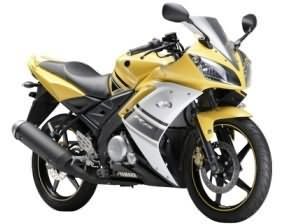The all new Yamaha R15 is the first of its kind in Indian market from Yamaha designed for power, looks and power the mean machine is fully packed state of the art technologies. The design is similar to that of YZF-R series. The Yamaha R15 has a 149.8cc fuel injected liquid cooled engine which generates an awesome 17 bhp with a torque of 15 Nm at 7500 rpm this makes it the most powerful bike under 200 cc range and has 6 speed gears.
R15 has India’s first 150cc 4 valve engine with forged pistons, Deltabox frame & 6speed gear box. It’s overall length is 1995mm, overall width is 670mm and its wheels base is 1290mm. Since sporty YZF R15 is shorter too and its height is just 1070mm. YZF R15 features F 80/90 -17 inches tyres in the front and 100/80-17 inches tyres in the rear. Both the tyres are tubeless.
New Graphics options for Yamaha YZF R15
Yamaha R15 has been introduced in new colours and body graphics, the new R15 is now available in four new shades that are “Midnight black”, “Sunset Red”, and “Racing Blue”, “Impact Yellow”. Here are all the options:-
- Yamaha Blue
- Yamaha White
- Sunset Red
- Midnight Black
- Impact Yellow
There is a new design on the side flaps which extends to the tank of the bike. There is a new R15 sticker above the left headlamp. Yamaha has also provided the rim stripe tape in the Yellow, red and black bikes. The ex-showroom price New R15 is around Rs 2,000 higher than the previous version which comes to around 99500.00 (Ex-Showroom New Delhi).
Looks and Style of Yamaha R15
Yamaha R15 has all the characteristics of motorcycles which designed by Yamaha to represent the R series which reflects the philosophy running through these models — expressing performance visually. For example, YZF-R6 shows a strong body line that springs up in a single line from the rear axle to the pivot and then to the head pipe. This is a visual expression of the straight shape of the Deltabox frame.
These elements are a visual expression of “frame rigidity.” Viewed from the side, the shape of Yamaha R15 created by the side panel and the upper surface of the tank creates an impression of the center of gravity shifting to the front tire. This is a visual representation of how the front tire grips the road in its sporty running performance. Needless to say, YZF-R1, with its athletic build, is also a visual expression of performance. A characteristic of the R series is that, when you view the machine, you get a sense of its concept and performance.
This philosophy has been fully transmitted to YZF-R15. An important point to note is that this motorcycle is not a scaled-down version of YZF-R1 or YZF-R6. YZF-R15’s design is based on having an excellent engine cooling method. The shape of the cowling around the radiator area was determined so that the shapes of the air intake area and the rear outlet area where the air is scooped out are optimized to improve radiator efficiency. As for the outlet area, the mid-cowl area was designed using sculpturing 3D methods to create a three dimensional shape with a sense of volume. rst for the Indian market. When viewed from the front, Yamaha R15 gives a sense of volume that seems well beyond its 150cc displacement. This does not simply mean that it is voluminous, but that it is grounded in the Art of Engineering which transforms function into art.
The core of Yamaha R15 (Engine)
YZF-R15 is powered by an all-aluminum cylinder called the DiASil Cylinder and a forged piston, the same type of piston used in Yamaha’s supersport bikes. The fact that both the piston and cylinder of YZF-R15 are all-aluminum ensures excellent heat dissipation, eliminates heat-induced engine power loss, and helps improve fuel efficiency. The DiASil Cylinder is given a special surface treatment to prevent oil evaporation from the cylinder’s surface and improve oil consumption. The cylinder also has excellent hardness and is considerably resistant to wear compared to conventional iron sleeves.
Additionally, the piston of Yamaha R15 is made in a forging process, the optimum way of achieving lightweight designs.The reciprocating mass with the forged piston is approximately 20% less ( according to Yamaha test ) than with an engine of the same displacement fitted with a conventional cast aluminum piston. Resulting in an invigorating feeling when revving up. Conventional pistons are typically made in a casting process where molten aluminum is cast in a mold.
Yamaha developed its proprietary “controlled forging technology” in 1997, which enables mass production of forged aluminum pistons. These pistons have been used in sport models such as the R series. The same manufacturing process was used to develop YZF-R15. Forged pistons retain the excellent strength of aluminum alloys because the metallurgic matrix of aluminum is not affected during the fabrication process. Therefore, the piston can be made lighter and thinner.
Chassis of Yamaha R15
YZF-R15 comes with a linked type monocross suspension that delivers a comfortable ride and a cushioning performance that is less prone to bottoming out. In particular, it reduces annoying “sinking” when riding tandem. The linked monocross suspension consists of a link mechanism sandwiched between the rear arm and cushion unit to create changes in the lever ratio based on the lever effect. When the shock absorber is almost fully extended, the lever ratio is high and therefore the spring is soft, and the damper works softly as well.
As the shock absorber strokes in, the lever ratio of Yamaha R15 gradually decreases and the spring rate increases. Eventually, when it is nearly fully stroked in, the lever ratio becomes small and the spring becomes hard and strong. The damper also becomes hard. By making changes to the lever ratio in this way, we were able to achieve soft riding comfort as well as excellent damping under intense load conditions.
The optimization of the frame and rear arm rigidity of the Deltabox Frame of Yamaha R15 combined with the effects of the linked type monocross suspension achieve good riding comfort, agile handling, and turnability, hardly ever causing bottoming out. In order to maximize the efficiency of the fuel injector, which injects the optimum amount of fuel for different amounts of intake air, YZF-R15 is equipped with a large 3-liter air cleaner. The duct area of the intake duct was designed optimally to optimize the flow of intake air.
Additionally, the use of a 4-valve combustion chamber (a combustion chamber with 2 intake and exhaust valves each) has allowed designers to layout the spark plug at the center of the combustion chamber for better flame propagation. This also increases the total valve area relative to the 2-valve chambers for improved intake/exhaust efficiency (volumetric efficiency). YZF-R15 is fitted with a hemispherical 4-valve combustion chamber, a configuration that allows intake and exhaust valves to be laid out in the smallest size possible.
Racing Kit Parts For Yamaha R15
Yamaha has launched a range of exclusive racing kit parts for its customers. Built by Yamaha Engineering Corporation and specialist firm, Daytona in Japan, these parts are exclusively for racing purpose in a closed circuit only. The parts include race ECU, high lift cams, full exhaust system, special alloy sprockets, adjustable back steps and braking parts like big diameter petal disc brakes, master cylinder, and stainless steel hose. Here are the prices:
Price
The price of Yamaha R15 Bike is between Rs. 1,03,000 On Road Price Rs. 1,09,500
Technical Specifications
| Dimensions & Weights | |
| Length (mm) | 1,995 |
| Width (mm) | 670 |
| Height (mm) | 1,070 |
| Wheelbase (mm) | 1,290 |
| Ground Clearance (mm) | 160 |
| Seat height (mm) | 790 |
| Kerb Weight (kgs) | 131 |
| Engine | |
| Type | Liquid-cooled, 4-stroke, SOHC, 4-valve |
| Displacement (cc) | 149 .8cc |
| Transmission | Return type 6-speed |
| Suspension | |
| Front | Telescopic |
| Rear | Linked type Monocross |
| Brakes | |
| Front Brake Type | Hydraulic, single disc |
| Rear Brake Type | Hydraulic, single disc |
| Tyres | |
| Front | 80/90-17 |
| Rear | 100/80-17 |
| Performance | |
| Max. Horsepower | 17PS / 8,500rpm |
| Max. Torque | 15 N.m / 7,500rpm |
| Fuel Tank Capacity (liter) | 12 liters |


